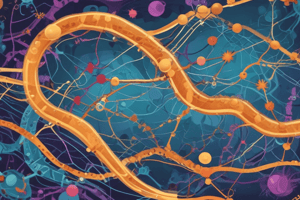Podcast
Questions and Answers
If the mRNA codon sequence is 5’-CUU-3’, then the corresponding tRNA anticodon (from 5’- to -3) would be?
If the mRNA codon sequence is 5’-CUU-3’, then the corresponding tRNA anticodon (from 5’- to -3) would be?
GAA
What are the three phases that characterize translation in all cells?
What are the three phases that characterize translation in all cells?
- Initiation, Elongation, Termination (correct)
- Incorporation, Modification, Regulation
- Transcription, Transformation, Translocation
- Encoding, Decoding, Reading
What is the role of ribosomes in translation?
What is the role of ribosomes in translation?
Ribosomes are the sites of protein synthesis.
Wobble base pairing allows some tRNAs to recognize more than one codon.
Wobble base pairing allows some tRNAs to recognize more than one codon.
What is the result after the completion of translation?
What is the result after the completion of translation?
What is the function of a chaperon in post-translational modifications?
What is the function of a chaperon in post-translational modifications?
How can translation be globally regulated?
How can translation be globally regulated?
MiRNAs bind to 5' UTR sequences to inhibit translation. (True/False)
MiRNAs bind to 5' UTR sequences to inhibit translation. (True/False)
Misfolded proteins can undergo __________ resulting in proteasome degradation.
Misfolded proteins can undergo __________ resulting in proteasome degradation.
Flashcards are hidden until you start studying
Study Notes
Translation of mRNA-Protein Synthesis
- Translation occurs in three distinct phases: initiation, elongation, and termination
- Key components required for translation initiation:
- Three types of RNA: mRNA, rRNA, and tRNA
- GTP (guanosine triphosphate)
- A set of soluble protein factors (initiation factors)
mRNA Structure
- mRNA consists of:
- Untranslated regions (UTR)
- 5'-UTR (upstream of start codon)
- 3'-UTR (downstream of stop codon)
- Protein coding sequence (start codon to stop codon)
- Polyadenylation signal in 3'-UTR
Genetic Code
- 64 possible codons
- 61 codons encode specific amino acids
- 1 codon encodes start codon (methionine, AUG)
- 3 codons are stop codons (UAA, UAG, UGA)
- Similar genetic code in mitochondria with few variants
Ribosomes
- Ribosomes are the sites of protein synthesis
- Composed of rRNA and proteins
- Large and small subunits
- Sedimentation coefficient or S value determines ribosome size
- E. coli has 20,000 ribosomes, while mammalian cells have 10 million ribosomes
rRNA Synthesis and Processing
- In eukaryotes, rRNA synthesis occurs in multiple genes organized in clusters
- Transcribed by RNA polymerase I
- Post-transcriptional cleavages occur
tRNA Structure
- tRNAs are short, single-stranded RNA molecules (80 bases long)
- Contain stem loop structures, modified bases, and unusual bases
- 3'-end is the amino acid attachment site
- Anticodon site base pairs with the codon at mRNA
tRNA-Anticodon and Codon Pairing
- Correct match between tRNA anticodon and mRNA codon is necessary
- Amino acid attached to tRNA is specified by the anticodon and identifier sequences
- Anticodon is 3 nucleotides in tRNA that pair with a mRNA codon
- Codon is 3 nucleotides in mRNA that code for a single amino acid
Wobble Base Pairing
- Wobble base pairing allows some tRNAs to recognize more than one codon
- Redundancy/degeneracy of the genetic codons acts as a buffer against deleterious mutations
Amino Acid Attachment to tRNA
- Amino acid attachment to tRNA occurs through aminoacyl-tRNA synthetase
- The process requires energy in the form of ATP
- The amino acid is covalently attached to the ribose of the terminal adenosine at CCA
Translation Initiation
- Formation of initiation complex involves:
- Ribosome binding site
- P site (holds the tRNA that carries the growing polypeptide chain)
- A site (holds the tRNA that carries the next amino acid to be added to the chain)
- E site (tRNAs leave the ribosome)
- Initiation site is specific: AUG (methionine) in both prokaryotes and eukaryotes
- Large and small ribosomal subunits
- In prokaryotes, initiation sites have a Shine-Dalgarno sequence that precedes the AUG initiation codon
- In eukaryotes, mRNAs are bound to the 40S ribosomal subunit by their 5' caps, and the ribosome then scans along the mRNA until it encounters an AUG initiation codon
Translation Elongation
- Three steps:
- Next aminoacyl-tRNA binding
- Peptide bond formation
- Translocation
- eEF1α (eukaryotic elongation factor) brings the next aminoacyl-tRNA to the A site
- Peptide bond is formed by the transfer of methionine to the aminoacyl tRNA at the A site
- The ribosome then moves three nucleotides along the mRNA, translocating the peptidyl tRNA to the P site and the uncharged tRNA to the E site
Translation Termination
- A termination codon (e.g., UAA) at the A site is recognized by release factors
- The result is the release of the completed polypeptide chain, followed by the dissociation of tRNA and mRNA from the ribosome
Polyribosome
- Polyribosome is a cluster of ribosomes bound to a single mRNA molecule
- Allows for simultaneous translation of the same mRNA to make many copies of the polypeptide quickly
Post-Translational Modifications
-
- Chaperon: protein responsible for proper folding of protein
-
- Addition of lipid
-
- Addition of carbohydrate
-
- Proteolytic processing
Regulation of Translation
-
- Global Regulation: translation can be controlled globally by regulating the activity of initiation factors
-
- Binding of repressor proteins: regulated by proteins that bind to specific sequences in the 3' untranslated regions of some mRNAs
-
- Binding of non-coding RNA (miRNA): miRNAs bind to 3' UTR sequences to inhibit translation and stimulate mRNA degradation
Studying That Suits You
Use AI to generate personalized quizzes and flashcards to suit your learning preferences.




